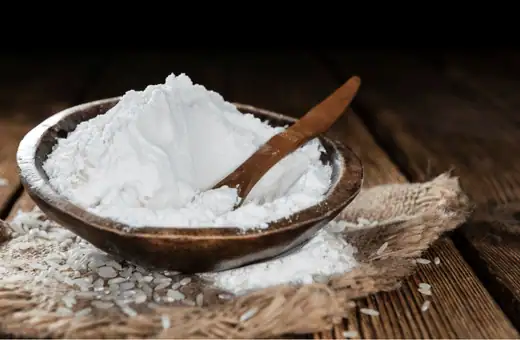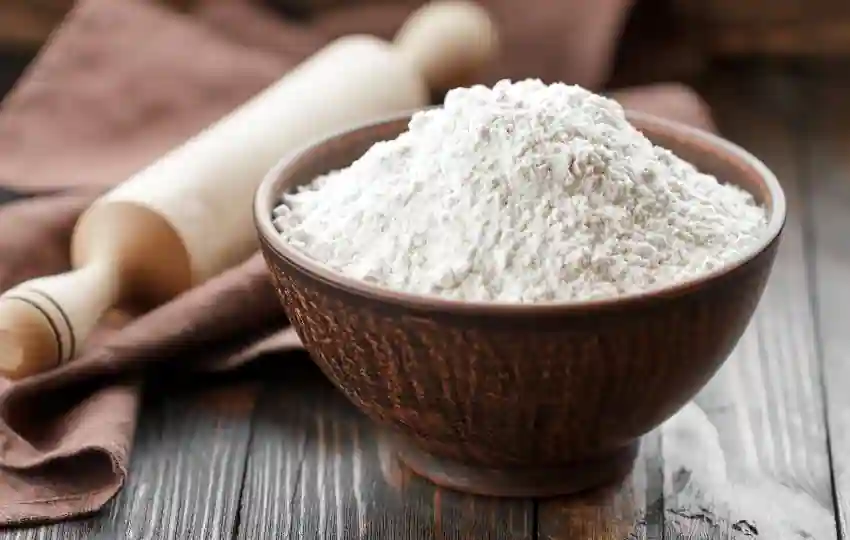Anyone who has made tempura knows that the key ingredient is tempura flour. However, there are times when you might not have any on hand, don’t worry!
There are several substitutes for tempura flour that will work just as well. Here are a few of our favorites.
Likewise, you can try All-purpose flour, Rice flour, Wheat flour, cornstarch, Cake flour, pastry flour, Tempura batter with self-raising flour, Potato Starch and Regular Flour, Okonomiyaki Flour, Chickpea Flour, Glutinous rice flour, Buckwheat Flour, Corn flour, etc. instead of tempura flour.
13 best substitute for Tempura flour in detail
1. All-purpose flour – a good replacement for tempura flour
All-purpose flour is the most common substitute for tempura flour. It’s easily accessible and usually already present in most pantries.
All-purpose flour is not as light and crisp as rice flour or potato starch, but it will still work in a pinch.
To use all-purpose flour as an alternate, simply replace the tempura flour called for in your recipe with an equivalent amount of all-purpose flour.
2. Rice flour – gluten-free alternative to tempura flour
Rice flour is another common substitute for tempura flour. Rice flour produces lighter, crisper tempura than all-purpose flour.
It’s also gluten-free, so it’s a good option for those with gluten sensitivities or allergies.

If you choose to use rice flour as a substitute, mix it with an equal amount of water before adding it to your batter.
However, it’s readily available at most grocery stores and Asian markets.
3. Try Wheat flour instead of tempura flour
Suppose you’re using wheat flour as a substitute for tempura flour in your tempura batter. In that case, you will need to make some adjustments to the recipe.
First, you will need to reduce the amount of wheat flour by about one-third since wheat flour is denser than tempura flour.
Additionally, you will need to add an acidic ingredient such as rice vinegar or lemon juice to help activate the gluten in the wheat flour and create a crispy batter.
Finally, you will need to use a larger amount of oil in the fryer since wheat flour tends to absorb more oil than tempura flour.
With these adjustments, you can successfully create a crispy and delicious tempura batter using wheat flour.
4. Tempura flour substitute cornstarch
Cornstarch is another great alternative to tempura flour. It’s readily available and will produce tempura that is light and crispy.
Simply replace the tempura flour called for in your recipe with an equal amount of cornstarch.
5. Cake flour – an ideal replacement for Tempura batter
Tempura batter is usually made with a combination of flour and ice water. To make a gluten-free version, you can use cake flour as a substitute for tempura flour.
6. Lower-gluten pastry flour gives you a similar flavor to Tempura flour
Pastry flour is a lower-gluten flour that makes a lighter, crisper tempura batter. It is used as a replacement for regular flour in tempura recipes.
The tempura will be less chewy and have a more delicate texture when made with pastry flour.
If you don’t have pastry flour on hand, you can make your own by mixing 1 cup (120 grams) of all-purpose flour with 2 tablespoons (15 grams) of cornstarch.
Sift the mixture a few times to combine. Use this in place of 1 cup (120 grams) of pastry flour in recipes.
7. Tempura batter with self-raising flour
Combine the batter ingredients together in a bowl and set aside for 10 minutes to rest.
In a deep-fryer or big heavy-based saucepan, heat oil to 190C (375F). Test the temperature by dropping a small portion of batter into the oil – it should sizzle and float to the surface.
Coat the shrimp in the batter, ensuring they are well coated.
Carefully drop the shrimp into the hot oil and cook for 2-3 minutes or until golden brown.
Release the oil with a slotted spoon and drain on a paper towel. Serve immediately with a lemon wedge, if desired. Enjoy!
8. Potato Starch and Regular Flour – an excellent replacement for Tempura flour
Potato starch is another good substitute for tempura flour because it also gives the batter a light and crispy texture. Replace the tempura flour with an equal amount of potato starch.
Read More- 13 Potato Flour Susbtitutes
9. Why not use Okonomiyaki Flour to substitute Tempura flour
To make a vegetarian version of tempura, replace the tempura flour with Okonomiyaki flour in the batter.
The Okonomiyaki flour will give the batter a light and airy texture. If you want a crunchier texture, you can add some cornstarch to the batter.
When cooking, deep-fry the battered vegetables or fish in vegetable oil until they are golden brown. Distribute with a dipping sauce, such as soy sauce or tonkatsu sauce.
Enjoy your vegetarian tempura!
10. Chickpea Flour – a decent Tempura flour substitute
To make the batter, mix together 1 cup of chickpea flour, 1/2 cup of ice-cold water, and 1/2 teaspoon of salt.
Put the veggies in the batter and then deep fry them in hot oil until they are golden brown. Serve with a dipping sauce of your choice.
11. Glutinous rice flour- gluten free replacemenet for tempura flour
To make the batter, mix together 1 cup of glutinous rice flour, 1/2 cup of all-purpose flour, 1 teaspoon of baking powder, and 1/2 teaspoon of salt.
Add enough cold water to make a thick batter.
12. Buckwheat Flour- Glutenfree Tempura flour Alternative
To make the tempura batter, mix together 1/2 cup buckwheat flour and 1/2 cup ice water. Season the batter with salt, pepper, and a pinch of cayenne pepper.
In a large skillet, heat 1/4 cup of vegetable oil over medium-high heat.
Put the veggies into the tempura batter and carefully add them to the hot oil. Fry the vegetables until they are golden brown and crispy.
Serve immediately with dipping sauce.
This tempura recipe is perfect for vegetables like broccoli, mushrooms, zucchini, and sweet potatoes.
You can also try using seafood like shrimp or fish. Serve the tempura with a dipping sauce like soy sauce, tonkatsu sauce, or sweet and sour sauce.
13. Tempura flour alternative Corn flour
To make the tempura batter, mix together 1 cup of corn flour, 1 cup of cold water, and 2 teaspoons of vegetable oil.
1 egg and 1/4 cup cold water are mixed together in a separate bowl. Combine together the wet and dry ingredients until completely blended.

To make the tempura, heat 2-3 inches of oil in a large pot or Dutch oven over medium-high heat. Once the oil is hot, dip your desired food into the batter, making sure it is well coated.
Carefully decrease the food into the hot oil and fry until golden brown and crispy. Serve immediately with your favorite dipping sauce.
Homemade Tempura flour
Making tempura flour at home is easy.
Simply mix 1 cup of all-purpose flour with 1/2 teaspoon of baking powder in a bowl. Stir until well combined, then set aside. In a separate bowl, whisk together 1/2 cup of water and 2 tablespoons of oil until combined.
Apply the wet ingredients to the dry ingredients, stirring until everything is well combined. Your tempura flour is now ready to use!
FAQs related to substituting for tempura flour
Q1. Is cornstarch the same as cornflour?
No, cornstarch is not the same as cornflour.
Corn flour is made from the endosperm of the corn kernel, while cornstarch is made from the germ. Corn flour is coarser than cornstarch and has a higher protein content. Cornflour is used as a thickening agent in sauces and soups, while cornstarch is used as a binder in recipes such as cakes and pies.
Both cornstarch and cornflour can be used to dust surfaces to prevent sticking, but cornflour is more commonly used for this purpose. Corn flour can also be used to make a gluten-free flour mix.
So, while cornstarch and cornflour are similar, they are not the same. When a recipe calls for one, be sure to use the correct ingredient to ensure your dish turns out as intended!
Q2. What is the difference between buckwheat flour and regular flour?
Buckwheat flour is made from the seeds of the buckwheat plant, which is not related to wheat. Unlike wheat flour, which is made from the endosperm of the wheat grain, buckwheat flour is made from the entire buckwheat seed.
This gives it a higher protein and fiber content than wheat flour. Buckwheat flour also has a lower gluten content, which makes it suitable for people with celiac disease or gluten intolerance.
In terms of baking, buckwheat flour can be used as a substitute for wheat flour in most recipes. However, it should be noted that buckwheat flour produces a denser end product than wheat flour.
Consequently, recipes that call for light and airy baked goods, such as cakes or biscuits, may not turn out as expected if you apply buckwheat flour. When substituting buckwheat flour for wheat flour in a recipe, it is generally recommended to use a 1:1 ratio.
Q3. Is chickpea flour Keto friendly?
Chickpea flour, also called garbanzo bean flour, is a versatile and healthy flour that can be used in a variety of keto-friendly recipes. Chickpea flour is rich in protein and fiber, making it an excellent source of nutrition for those on the keto diet.
What’s more, chickpea flour is low in carbohydrates and calories, making it a great choice for those looking to lose weight on the keto diet. And because chickpea flour is gluten-free, it’s also a good option for those with gluten sensitivities or celiac disease.
So whether you’re searching for a healthy way to add extra protein and fiber to your diet or you’re simply trying to find a keto-friendly flour option, chickpea flour is a great choice.
Q4. What is the difference between gram flour and chickpea flour?
Gram flour and chickpea flour are both made from ground chickpeas, but they differ in their texture and flavor. Gram flour is made from raw chickpeas that have been soaked and ground into a fine powder.
Chickpea flour, on the other hand, is made from roasted chickpeas that have been ground into a coarse meal. The roasting process gives chickpea flour a nutty flavor that is absent in gram flour. Chickpea flour is also more absorbent than gram flour, making it ideal for recipes that require a thick batter, such as pancakes or fritters.
When substituting one for the other, it is important to keep these differences in mind. Chickpea flour is also more commonly used in gluten-free baking, as it produces a lighter, fluffier texture than its coarser counterpart.
Whether you use gram flour or chickpea flour will ultimately depend on your personal preferences and the recipe you’re following.
Q5. Is pastry flour and cake flour the same?
Although pastry flour and cake flour are both made from wheat, they have different protein content levels, which results in flours with distinct properties. Cake flour has lower protein levels than all-purpose flour, and as a result, it produces baked goods with a light, tender texture.
Pastry flour has protein levels that fall somewhere between those of cake flour and all-purpose flour; it is usually utilized in recipes that call for a delicate crust or flaky texture.
Although pastry flour and cake flour can be used interchangeably in some recipes, it is important to note that the final product may differ slightly in terms of texture. For best results, it is always best to use the type of flour specified in the recipe.

